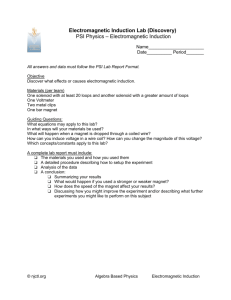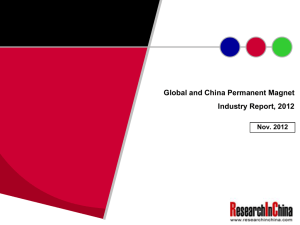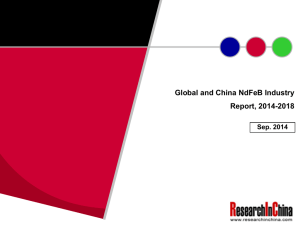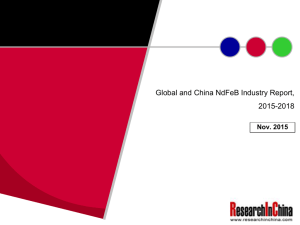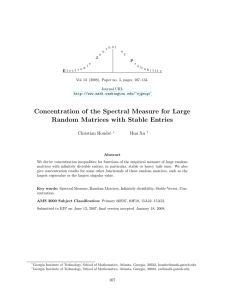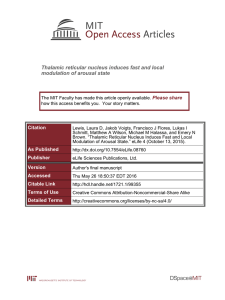Human Motion Energy Harvesting by Design of Handheld Linear PM
advertisement
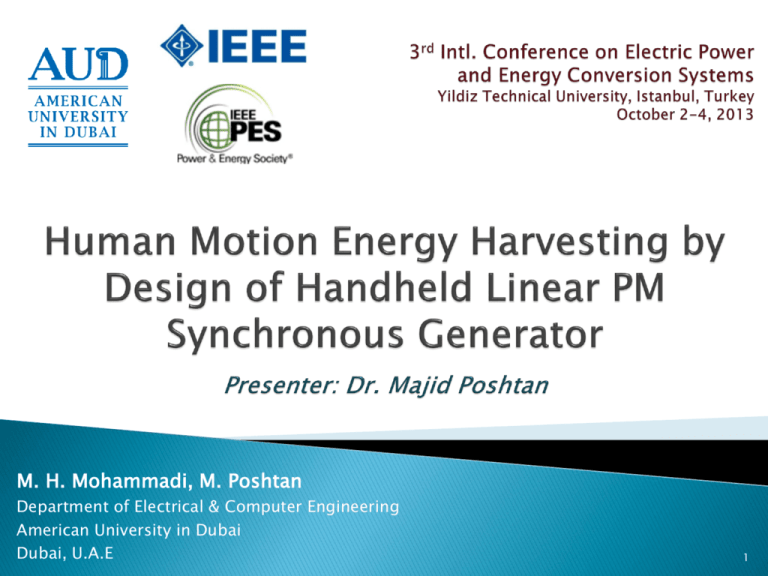
M. H. Mohammadi, M. Poshtan Department of Electrical & Computer Engineering American University in Dubai Dubai, U.A.E 1 1. Introduction 4. PM Material Selection Grade & Size of Chosen PM Generator Design Structure 5. Feasibility Study of Solenoid 2. 3. 6. Test 1, Test 2, Test 3 Generator Prototype Comparison 7. Power Charging Circuit 8. Application: Vision Stick Conclusions Question Session 9. 10. 2 Renewable energy source projects require government & multinational company investments US Residential Sector = 19% of US Energy Use [1] ◦ Widespread use of electronic devices (e.g. mobile phones, music players, tablets, …) ◦ Involve common people to self-generate power Aim for an energy-aware society toward a more sustainable future 3 Basis on Faraday’s Law of Induction e = – N dϕ/dt Linear AC Synchronous Generator Power Generation Optimization: Magnet Material Magnet Shape Solenoid Wire Thickness Number of Turns 4 Common Magnet Material Properties [4] BHmax Flux Density Coercive (kJ/m3) (mT) Force (Hc) Ceramic 26 100 High Alnico 42 130 Low SmCo 208 350 High NdFeB 306 450 High Material 2nd Quadrant of Hysteresis Curve [3] Sintered NdFeB Magnet Grades [2] Operate PM for: ◦ High magnetic strength ◦ Portable charging ◦ Optimum flux linkage Grade Br (T) Hcb (kA/m) BHmax (kJ/m3) Density (kg/m3) Max Working Temp. (°C) N35 N38 N40 N42 N45 N48 N50 N52 1.18 1.22 1.25 1.28 1.32 1.38 1.40 1.44 867.4 899.2 923.1 923.1 875.4 835.6 795.8 835.6 278.5 302.4 318.3 334.2 358.1 382.0 397.9 413.8 7400 7400 7500 7500 7600 7700 7800 7800 80 80 80 80 80 80 80 80 5 Up: Different Magnet Shapes Left: Comparison of Magnet Strengths 6 Constant structure for solenoid design Cylindrical Structure (12cm long) ◦ Insulation paper material ◦ 2cm of wire wrapping space ◦ 2.1cm of tube diameter 7 Solenoid parameters: Wire diameter ◦ Tests 1 & 2 Number of turns ◦ Test 3 Design criteria: 5V RMS output Shaking frequency > 5Hz Direct Relationship between Total Wire Resistance & Number of Turns 8 Constant Parameters: ◦ Magnet 1 (NdFeB Cylindrical) AC Voltage Sample Waveform ◦ Generator structure ◦ 4 different manual shaking frequencies Low Frequency (LF) range: 0 to 5Hz Medium–Low Frequency (MedLF): 6 to 10Hz Medium–High Frequency (MedHF): 11 to 15Hz High Frequency (HF): 16 to 20Hz Variable Parameter: ◦ Solenoid wire diameter (15 sizes) From 0.10mm to 0.85mm in 0.05mm step increments (approx.) 9 Densities for MedHF freq: Voltage-Turn: 4.50mV/trn Current-Turn: Power-Turn: 5.00mA/trn 0.90mW/trn Power-Turn Density in Test 1 10 Same parameters as Test 1, except ◦ Magnet 2 (NdFeB Triple Ring) Voltage-Turn Density in Test 2 Current-Turn Density in Test 2 11 Densities for MedHF freq: Voltage-Turn: 8.00mV/trn Current-Turn: Power-Turn: 8.00mA/trn 2.00mW/trn Power-Turn Density in Test 2 12 Constant Parameters: ◦ ◦ ◦ ◦ Magnet 2 (NdFeB Triple Ring) Solenoid wire diameter (0.28mm) Generator structure 4 different manual shaking frequencies Low Frequency (LF) range: 0 to 5Hz Medium–Low Frequency (MedLF): 6 to 10Hz Medium–High Frequency (MedHF): 11 to 15Hz High Frequency (HF): 16 to 20Hz Variable Parameter: ◦ Solenoid number of turns 1 Level = 2cm centered space = 65turns 13 1 Level for 0.28mm wire diameter = 65 turns Down: RMS Voltage Generated in Test 3 Up: RMS Current Generated in Test 3 14 Values for Level 15 in MedHF freq: NL Voltage: 7.0mV/trn NL Current: Power: 250.0mA/trn 1600.0mW Power Generated in Test 3 Chosen Solenoid Parameters: Wire diameter: 0.28mm Number of turns: 975 turns 15 1 o o o Power = 140 mW Mass = 56 g Power Mass Density = 2.5 mW/g 2 o o o Power = 1600 mW Mass = 150 g Power Mass Density =10.7 mW/g Prototype #2 is 4 times more power-mass efficient 16 Match mech. shaking to e-charging time constant: ◦ Avg. shaking frequency: 5Hz ◦ Resistance of generator: 23Ohms ◦ Chosen Capacitance: 9.4mF (2x4.7mF) Down: Oscilloscope Waveform of Charging Voltage Up: Power Charging Circuit of 2000mAh Battery Supply 17 Senior Design Project (3 members + supervisor) Enables visually-impaired people to navigate more easily and provides an emergency help option Winner of the ESREC13 Competition amongst 30 teams 18 Portable Generator ◦ Charge system batteries with designed LPMSG Detection & Alert System ◦ Detects nearby objects & alerts user via vibration Emergency System (down) ◦ Automatically obtains GPS coordinates & sends “HELP” SMS to emergency contact Extra Features Automatic LED switching (right) Stick folding (down) 19 Emergency SMS ◦ Consumes: 260 mA ◦ Average Time Taken: 2 mins ◦ Charge Needed: 8.67 mAh Portable Battery Supply ◦ Capacity: 2000 mAh ◦ On Full Battery Charge: Sends 230 SMS ◦ For 1 Extra SMS, Shake Generator for: Max Time: 15 mins Min Time: 10 mins 20 A portable Linear Synchronous PM Generator (LPMSG) was power optimized to meet the required specifications for charging electronic devices. Improved power generation through: ◦ Stronger N52 grade NdFeB magnets ◦ Specifically-Designed magnetization directions ◦ Guiding magnetic flux through design iron core. A squirrel-cage low reluctance core incorporates lower losses compared to air. 21 22 [1] [2] [3] [4] F. Bressand et al., “Wasted energy: How the US can reach its energy productivity potential”, McKinsey Global Institute, pp. 67, June 2007. Magnet Sales. Magnets. United Kingdom. 2013 [Online]. Available: http://www.magnetsales.co.uk Shin-Etsu Chemical Co. Rare Earth Magnet Basics. 2007 [Online]. Available: http://www.shinetsu-rare-earth-magnet.jp/e/design/ Stephen P Beeby and Terence O'Donnell, "Electromagnetic Energy Harvesting," in Energy Harvesting Tecnologies, Shashank Priya and Daniel J Imman, Eds.: Springer. 23
